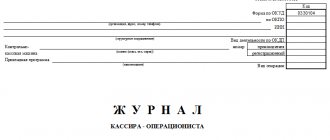Stages of the liquidation procedure
To get an answer to the question “Should the liquidation balance be zero or not?”
Let's look at several points related to the liquidation procedure of an enterprise. In Art. 61–64 of the Civil Code of the Russian Federation highlight the stages that a company must go through during liquidation:
- Making a decision by the management body or the sole owner to close the enterprise.
- Informing the tax inspectorate about the decision made to change data in the Unified State Register of Legal Entities.
- Approval of the special liquidation commission.
- Public communication about the cessation of activities, for example, through the media, on Internet resources.
- Carrying out an inventory of property and liabilities, taking measures to collect receivables and notifying creditors of the liquidation of a legal entity.
- Drawing up an interim liquidation balance sheet.
- Final settlement with creditors.
- Drawing up the final (final) liquidation balance sheet
- Distribution of the property of a legal entity remaining after satisfying the claims of creditors to its founders (participants).
- State registration of the results of company closure.
So, during the liquidation process, several liquidation balance sheets can be drawn up: interim and final. However, they should not be the same.
Read more about the liquidation procedure in the article “Procedure for closing an LLC - step-by-step instructions.”
LLC liquidation process
Liquidation of an LLC involves the use of a number of documents :
- certificate confirming the registration of the organization;
- extract from the Unified State Register of Individual Entrepreneurs/Unified State Register of Legal Entities;
- charter;
- constituent agreement;
- certificate of registration;
- information about the statistics codes used;
- notifications received from funds;
- stamp (seal);
- minutes of the meeting of participants;
- photocopied versions of passports and certificates of participants.
In 2020, the LLC liquidation procedure consists of the following stages .
- Making a general decision . Appointment of a liquidation commission with determination of procedures and deadlines for termination of activities. Notification of the decision to the tax office. Drawing up a notification in form P15001.
- Publication of relevant information in the media . Registration of balance. Identification of the existence of debt and written notification of the decision to creditors. Carrying out settlements on debt obligations. Providing a set of documents to the registration authority.
- Preparation of liquidation balance sheet . Transfer of property property to the founders. Preparation of the appropriate notification.
- Transfer of documents by the tax service for storage in the archive.
From this moment on, the LLC is considered liquidated and can no longer conduct activities.
Details on the preparation of interim liquidation reporting are presented in the video below.
Interim liquidation balance sheet
An interim liquidation balance sheet is drawn up by the liquidation commission only after the deadline for submitting claims by creditors (Clause 1, Article 63 of the Civil Code of the Russian Federation).
The interim liquidation balance sheet must contain information:
- about the property of the liquidated organization (based on inventory results);
- a list of claims presented by creditors and the results of their consideration;
- a list of demands satisfied by a court decision that has entered into legal force, regardless of whether such demands were accepted by the liquidation commission.
Data on property must be confirmed by inventory materials (clause 27 of the PBU on accounting and accounting, approved by order of the Ministry of Finance of the Russian Federation dated July 29, 1998 No. 34n). As a rule, the list of claims presented by creditors and the results of their consideration by the liquidation commission are given in the appendix to the balance sheet; the received document is numbered, stitched and sealed on the back. Thus, based on the requirements for the interim liquidation balance sheet, it can be argued that it cannot be zero.
The interim liquidation balance sheet is approved by the founders (participants) of the legal entity or the body that made the decision on liquidation. In some cases, the interim liquidation balance sheet is approved in agreement with the authorized government body. This procedure is provided for in paragraph 2 of Art. 63 Civil Code of the Russian Federation. Please note that you should not approve an interim liquidation balance sheet if at least one of the following circumstances occurs:
- the court accepted the creditor's claim against the liquidated company for proceedings, and the decision in this case (another judicial act completing the proceedings) has not yet entered into legal force;
- An on-site tax audit is being carried out in relation to the liquidated company, and the final document on it has not yet entered into force.
The law does not directly prohibit the approval of an interim liquidation balance sheet in each of such cases. However, if there is at least one of them, it is impossible to submit a notification to the tax authority about the preparation of an interim liquidation balance sheet (subparagraphs “b”, “c”, paragraph 4, article 20 of the law “On State Registration...” dated 08.08.2001 No. 129-FZ ).
Despite the fact that Law No. 129-FZ does not directly indicate the obligation to submit the interim liquidation balance sheet to the registration authority, it is necessary to submit it, since without an interim balance sheet it will be impossible to verify the reliability of the liquidation balance sheet. And the reliability of the liquidation balance sheet is a necessary condition for registering the liquidation of an organization.
Is it possible by one decision of an LLC participant to approve both the interim and liquidation balance sheets and submit all documents to the Federal Tax Service at the same time? ConsultantPlus experts provided detailed explanations. Get trial access to the system and review the recommendations for free.
The decision to compile
Drawing up a document is mandatory for every organization after making a decision to close. It does not matter for what reason the founders decided to liquidate the company: voluntarily or based on a court decision. A report can be drawn up only after creditors have filed claims against the liquidated organization. This provision is enshrined in paragraph 1 of Art. 63 Civil Code of the Russian Federation.
Members of the liquidation commission themselves set the deadline for accepting creditors' claims. By law, it should not be less than 2 months from the date of contacting the tax office with a decision to close. Accordingly, the LPB is also compiled no earlier than 2 months later.
If management delays the process, the procedure is suspended. This stage is of great importance in the process of closing a company, so it should be given special attention.
The liquidation balance must be zero or not
After all settlements with creditors have been completed, a liquidation balance sheet is drawn up, which must also be approved by the founders (participants) of the legal entity or the body that made the decision to liquidate the legal entity (clause 6 of Article 63 of the Civil Code of the Russian Federation). And here again the question arises: “Should the liquidation balance be zero or not?” The answer to this question is ambiguous. The fact is that at the moment there is no unified methodological approach, enshrined in the legal acts, to the procedure for compiling indicators of the final liquidation balance sheet. In addition, Art. 63 of the Civil Code of the Russian Federation does not establish the priority of drawing up a liquidation balance sheet before the distribution of property between owners. It only states that both of these actions must occur after the creditor has been repaid. It also makes it difficult to answer the question “Should the liquidation balance be zero or not?” the fact that the issue of the competence of the liquidation commission to independently make a decision on the distribution of property remaining after settlement with creditors among the participants (founders) is not regulated by law.
In principle, both positions are valid: that it should be zero, and that it can have indicators (except for the creditor).
Thus, if we assume that the liquidation commission is authorized to distribute the property remaining after settlement with creditors between shareholders and the liquidation balance sheet can be drawn up after the distribution of property, then the answer to the question “Should the liquidation balance sheet be zero or not?” positive.
If we assume that the decision on the distribution of property remaining after settlement with creditors is made by shareholders, and the liquidation balance sheet must contain information about such property, then the answer to the question “Should the liquidation balance sheet be zero or not?” negative.
Due to the uncertainty of the legislation on this issue, it seems that both of the stated positions may be valid, although each of them has its disadvantages.
To learn how property can be divided between participants, read the material “How is property distributed during the liquidation of an LLC?”
Download application P15001 (form and sample)
3227 downloads
Form p15001 (interim liquidation balance sheet)9689 downloads
After settlements with creditors are completed, a final liquidation balance sheet is drawn up. After its approval, you need to pay the state duty and send an application to the tax authority in form P16001 to register the termination of the company’s activities, after which the liquidation process is completed.
Consequences of drawing up zero and non-zero balances
The disadvantage of the first position may be the presence of receivables among the assets of the liquidated organization, the collection of which may take quite a long time, and accordingly, the preparation of the liquidation balance sheet will be postponed for an indefinite period (until all receivables are repaid). The second disadvantage of this position is the uncertainty in the procedure for resolving a possible dispute between the participants regarding which of them should receive the remaining property. According to paragraph 8 of Art. 63 of the Civil Code, in the event of a dispute regarding which of the participants needs to transfer an item, the liquidation commission must sell this item at auction, but it seems that certain difficulties may arise with this issue, because this item, by decision of the liquidation commission, has already been transferred to one of the participants. Obviously, in this case, a zero liquidation balance can be approved only after the dispute between the participants is resolved.
The disadvantage of the second position may be the presence among the assets of the liquidated organization of property subject to transport tax and (or) property tax. In this case, the liquidated organization continues to remain a payer of these taxes, and before the distribution or sale of this property, it continues to form accounts payable for these taxes. And, therefore, in this case the liquidation balance sheet cannot be approved, since there will be tax payables.
Deadlines for preparation and approval
Regarding the deadlines for drawing up, it should be noted that they are established by members of the liquidation commission. As previously noted, this period cannot be less than 2 months from the date of publication of the message in the Bulletin. The deadline is not regulated at the legislative level.
The approval of the balance sheet is also not regulated by law; the founders must simultaneously close all accounts, sell property and participate in audits by tax authorities. Employees of the Federal Tax Service must conduct an on-site inspection as quickly as possible, its duration does not exceed 2 months.
Liquidation balance sheet: sample filling
The liquidation balance sheet does not have a specially approved form. It is filled out on the form adopted by order of the Ministry of Finance of the Russian Federation dated July 2, 2010 No. 66. Its name must be indicated: interim liquidation balance sheet or liquidation balance sheet. Such recommendations were given in the letter of the Federal Tax Service of Russia dated 08/07/2012 No. SA-4-7/13101.
On our website you can download the balance sheet form “Filling out Form 1 of the balance sheet (sample)” .
The liquidation balance sheet is prepared according to the same rules as the regular quarterly and annual balance sheets.
For information on how to fill out a balance sheet, read the article “Procedure for drawing up a balance sheet (example)” .
There are no special rules for drawing up an interim liquidation balance sheet (you can download a sample of filling out a zero balance sheet during liquidation on our website).
Latest financial statements
And a few more words about the financial statements of a liquidated legal entity. Features of financial statements during liquidation are given in Art. 17 of the Law “On Accounting” dated December 6, 2011 No. 402-FZ. The reporting year of the liquidated company is incomplete. It begins, as usual, on January 1, but ends on the date preceding the date of entry into the Unified State Register of Legal Entities about its liquidation. On the date preceding the date of entry into the Unified State Register of Legal Entities of an entry on the liquidation of a legal entity, the latest financial statements are drawn up. It must be compiled on the basis of the approved liquidation balance sheet and data on the facts of economic life that occurred in the period from the date of approval of the liquidation balance sheet to the date of entry into the Unified State Register of Legal Entities on the liquidation of the company. Thus, the latest financial statements are a successor not to the previous financial statements, but to the liquidation balance sheet.
In sub. 9 clause 3 art. 21 of Law No. 402-FZ states that the composition of the latest financial statements, the procedure for their preparation and the monetary measurement of objects in them should establish federal standards. But today such standards have not been approved and the procedure for submitting such reports to any government bodies has not been established.
If you decide to liquidate a joint stock company, use the step-by-step instructions from ConsultantPlus. Get trial access to the system and upgrade to the Ready Solution for free.
Results
The liquidation balance sheet can be interim and final. The intermediate version must reflect information about the obligations, property and capital of the organization, and also contain a list of claims presented by creditors, the results of their consideration and a list of claims satisfied by a court decision that has entered into legal force, regardless of whether such claims were accepted by the liquidation commission. The interim liquidation balance cannot be zero.
The final liquidation balance sheet is drawn up after the completion of settlements with creditors and in it the item “Accounts Payable” should be equal to zero. There is no clear answer to the question “the liquidation balance should be zero or not.” The liquidation balance sheet does not have a specially approved form and is filled out on the form of a regular balance sheet.
Sources:
- Civil Code of the Russian Federation
- Order of the Ministry of Finance of Russia dated July 29, 1998 N 34n
- Federal Law of 08.08.2001 N 129-FZ “On state registration of legal entities and individual entrepreneurs”
- Order of the Ministry of Finance of Russia dated July 2, 2010 N 66n
- Federal Law of December 6, 2011 N 402-FZ “On Accounting”
You can find more complete information on the topic in ConsultantPlus. Full and free access to the system for 2 days.








